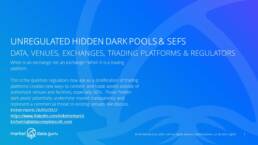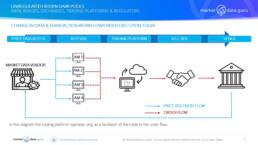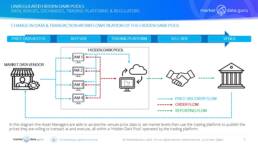DATA, VENUES, EXCHANGES, TRADING PLATFORMS & REGULATORS

WHY IS THIS AN ISSUE?
By definition a Dark Pool should be hidden, however the regulated ones are in reality ‘Dusk Pools’ operating in a twilight zone. So what if real ‘Hidden Dark Pools’ actually exist? Well leading regulators are increasingly investigating how traditional trading platforms that were once technology services to input, communicate, and facilitate trades have evolved into price discovery and execution services that can bypass authorised venues, thus creating true ‘Hidden Dark Pools’ which can influence markets from listed equities to SEFs to broader OTC trading.
In the US it is estimated on any given day between 40% and 60% of all equity trading is now via dark pools, while the EU has broadly banned this type of venue.
Dark pools are broadly regulated where they are allowed to operate, however, there are always other ways to trade which perhaps should regulators are considering placing under a supervisory regime.
WHAT DOES THIS MEAN?
29/09/2021 The US CFTC filed charges against a platform offering electronic trading services for not registering as a Swap Execution Facility (SEF). The CFTC based this upon the platform providing ‘a technological tool for automated request for quote (RFQ) workflow for interest rate and cross currency swaps,’ so that ‘multiple swap market participants to select swap product parameters, such as swap type, clearing preference, tenor, and notional size to populate RFQs’.
Both in the EU and the US the focus of attention has switched to the trading platform and application sitting on the desk. What started out as a way to see prices on an exchange, input and execute orders, trading platforms are evolving into venues in their own right. The technology and functionality required is not a huge step to go from a simple lateral flow to a multi-lateral flow within discreet, i.e. closed trading networks.
The result, holes are appearing in the dark pool and trading venue regulatory environment as technology outstrips oversight.
CHANGE IN DATA & TRANSACTION WORKFLOW
The key change is how price discovery works. In listed exchange markets, currently brokers enter their proposed transaction details into the exchange’s systems which then publishes bid/ask/volume data to enable transactions. The trading platform itself is merely an enabler, displaying what the exchange distributes, usually via prices delivered via a market data vendor.
What happens when a trading platform becomes a closed trading network within a larger trading universe, which is how Over-The-Counter (OTC) markets operate. There are two scenarios:
1. Entry Level. Each Trading platform is perfectly able to publish prices within its own network
2. Execution Level. Where the trading platform publishes the prices and acts as the venue. The trading takes place off market and trades are just reported back to the exchange or whichever responsible and authorised venue.
The dependence for this to occur is availability of price data, and voila, the trading platform is now a dark pool venue either authorised or not authorised, i.e. ‘The Hidden Dark Pool’.
Both scenarios meet the CFTC criteria, as well as develops the potential for creating an off market dark pool.
An important element to be considered is the differences between listed and OTC markets, plus the emergence of multi-asset class trading platforms. What is the same is that any trading platform that subsequently acts as a venue must have a licence.
The two diagrams below provide a high level view of the changes in the workflow when this happens.


REGULATORY INTEREST
26/01/2022. The US SEC released a proposal to amend the 1934 Securities Exchange relating to alternative trading systems (ATSs). This expands the definition of ‘exchange’ in trading US fixed income securities ‘to include systems that offer the use of non-firm trading interest and communication protocols to bring together buyers and sellers of securities,’ i.e. trading platforms.
ESMA has been quick to follow by publishing a consultation paper ‘ESMA’s Opinion on the trading venue perimeter’ seeking to ‘clarify the definition of multilateral systems and provide guidance on when systems should be considered as multilateral systems and, as consequence, seek for authorisation as trading venues’. Reed Smith in an excellent analysis provides more detail here.
WHAT COULD HAPPEN?
The answer is anything, however there are a lot of vested interests. Technology drives down costs, and financial institutions are averse to spending money (except on bonuses). The attraction of new venues and dark pool trading activity will see many trading platforms transition either to venues as a strategic decision or through unconsidered additions in functionality.
The obvious way to achieve this is to analyse the data flows for price discovery, and whether that data is being produced and distributed within a private and discreet environment. The resultant trading activity then defines if these are dark pools or open market activity.
For OTC Markets the trading platform/venue would require a licence as an Authorised Trading Venue, and for listed markets registered as a Dark Pool.
Whatever happens, regulators will look for clear delineation between a trading platform for Order & Execution Management (OEMS) and ones that facilitates price discovery and trading.
Keiren Harris
01 June 2022
For a copy of the article as a pdf file please email: info@marketdata.guru
For information on our consulting services please email:
knharris@datacompliancellc.com


